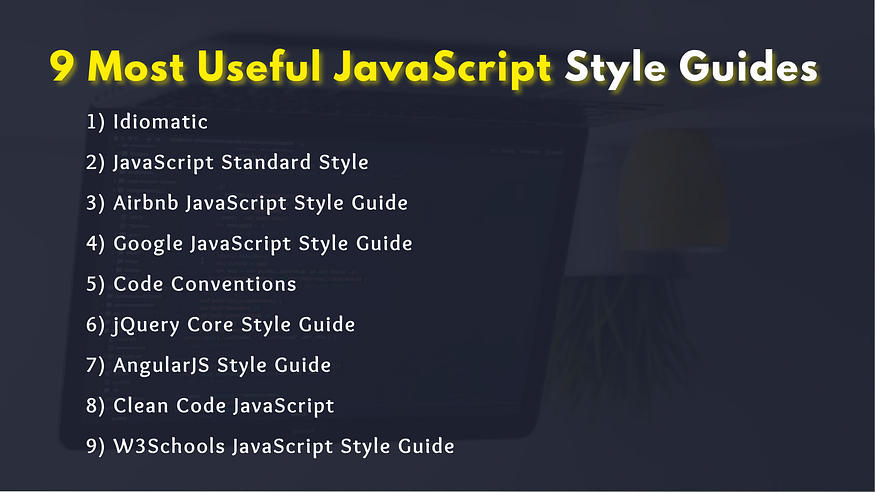
JavaScript is a widely used client-side programming language, utilized by 98.4% of all websites due to its dynamic, high-level, and interpreted nature, making it a popular choice for web applications. Its adaptability to various projects and low weight enables websites and applications created with JavaScript to be accessed seamlessly from any device and browser. Furthermore, its popularity is expected to remain dominant in 2023 due to its versatile functionality.
To ensure consistency and improve coding standards, a code style guide is essential for outlining the rules, standards, and best practices for writing, formatting, and organizing source code. For JavaScript, there are several recommended style guides available that can help teams to achieve a consistent coding style. Here are nine of the most useful style guides that can be utilized to achieve these goals.
9 Most Useful JavaScript Style Guides ✨

1. Idiomatic
The Idiomatic JavaScript style guide is widely recognized as one of the most popular guides for maintaining code consistency, readability, and maintainability. With an open-source model, developers are free to contribute to or customize the guide to their specific needs.
2. JavaScript Standard Style
JavaScript Standard Style is a user-friendly style guide released under an MIT license by Feross Abukhadijeh. It includes a linter and a code fixer that automatically formats code, and detects bugs and style issues, eliminating the need for multiple style configuration files. Developers can easily write code in their preferred style and format it with the standard node package using the simple command, standard — fix. This enhances efficiency and reduces the back-and-forth between code contributors and reviewers.
3. Airbnb’s JavaScript Style Guide
The Airbnb JavaScript Style Guide, introduced in 2012, is a comprehensive coding standard used at Airbnb. The guide emphasizes consistency, predictability, readability, and efficiency. It covers nearly all aspects of JavaScript, including objects, events, testing, and performance. The guide has gained significant popularity and is a useful starting point for developers looking to customize their coding standards.
4. Google’s JavaScript Style Guide
The Google JavaScript Style Guide, also released in 2012, outlines the coding standards used at Google. The guide is divided into two parts, one focusing on style rules and the other on language rules. The guide includes an ESLint package, making it easy for developers to incorporate it into their projects.
5. Code Conventions
Code conventions in JavaScript programming are a set of guidelines that provide recommendations on how to produce code that is clean, readable, and maintainable. The author of this set of conventions is Douglas Crockford, a renowned software developer, writer, and speaker who has contributed significantly to the development of the JavaScript language. Crockford’s JavaScript code conventions prioritize the readability and comprehension of code, stressing the importance of using whitespace, proper indentation, and consistent naming conventions.
6. jQuery Core
The jQuery Core JavaScript Style Guide is a module for jQuery developers that integrates and checks whether their code is written according to the standard jQuery Style Guide. It is developed by the jQuery project team to ensure that the code contained within the jQuery library is written in a clear, consistent, and comprehensible manner. This guide addresses various facets of JavaScript programming, including naming conventions, indentation, whitespace, comments, variables, functions, objects, arrays, and more. Additionally, the guide provides recommendations for utilizing prevalent jQuery patterns and best practices.
7. AngularJS Style Guide
The AngularJS Style Guide is a collaborative effort by the AngularJS community, aimed at establishing best practices for developing AngularJS applications in a coherent and sustainable manner. The guide encompasses a broad range of AngularJS development aspects, including file organization, naming conventions, coding style, performance optimization, and testing. Adherence to the AngularJS Style Guide promotes an enhanced quality of AngularJS applications, resulting in greater reliability and scalability.
8. Clean Code JavaScript
Clean Code JavaScript is a guidebook that has been adapted for the JavaScript language, based on the principles espoused in Robert C. Martin’s book, Clean Code. Its primary objective is to provide developers with a roadmap for creating software that is both readable and reusable, as well as amenable to refactoring. The guide emphasizes the use of precise and descriptive naming conventions, appropriate formatting, and the elimination of extraneous code to reduce complexity and enhance readability. Furthermore, Clean Code JavaScript places a strong emphasis on a modular design, recommending the use of well-organized functions and classes to promote reusability and maintainability. It is not merely a style guide, but a comprehensive guide for producing high-quality software in JavaScript.
9. W3Schools JavaScript Style Guide
The W3Schools JavaScript Style Guide is a comprehensive resource utilized by W3Schools, comprising a set of guidelines and best practices for producing top-notch JavaScript code. It encompasses an array of crucial areas, such as code formatting, variable declaration, function definition, error handling, and naming conventions. The guide prioritizes uniform and unambiguous naming conventions, while also emphasizing the significance of appropriate code indentation and whitespace utilization. Additionally, it encourages the use of comments to document code and offers guidance to future developers who may collaborate on the same codebase.
Conclusion
When working within a large team of developers, it is common for each individual to have their own distinct approach to coding. As a result, the codebase can become convoluted and difficult to comprehend, making the onboarding process for new developers all the more challenging.
To address this issue, the implementation of a style guide is highly recommended. A style guide is essentially a set of guidelines that developers adhere to when coding, with the aim of ensuring consistency across the team’s work. By integrating a JavaScript Style Guide into your coding routine, you can facilitate the creation of future-proof software that is more easily understood by all members of the development team.
